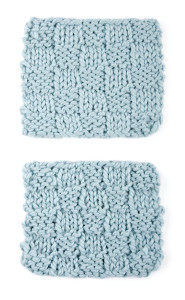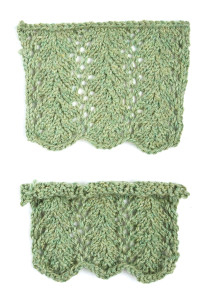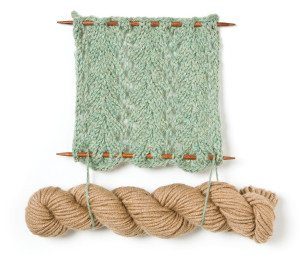Most avid knitters have seen countless articles on gauge. I know I certainly have. One thing not often mentioned is the probability of the gauge changing from the time pieces are knitted to when they are blocked, assembled and worn. As a yarn shop owner, time and again I’ve heard, “But I checked my gauge, and it was right while I was knitting it!” This article is not about how to measure gauge. Instead, I’ll explore the factors that can unexpectedly change the gauge during the course of a project.
The Many Factors that can Effect Gauge
Fiber Content
Wool is by far the most predictable fiber. Stitches worked in wool and more elastic yarns are more likely to stay true. However, softer animal fibers such as alpaca and many of the cellulose yarns such as cotton, bamboo and silk are notorious for spreading when washed (Photo 1). This can be devastating when you follow a garment pattern in which you remain true to gauge the entire garment only to find it 25 percent wider after you wash and block it.
Fabric or Stitch Patterns
Cables and ribs do not change dramatically from the time you knit them to the time you wash them. Usually these design elements do not present the problems that other fabrics or stitch patterns do. Lace knitting, however, can change dramatically from the needles and can block out 25 to 30 percent (Photo 2). Other stitch patterns, such as the garter stitch, will stretch vertically also.
Weight
So many times you will be right on gauge throughout a knitted piece, only to find drastic changes when you put the garment on. The weight of the garment now becomes relevant. It’s gravity.
We all know that gauge is important.
What I am stressing here is the importance of measuring your swatch as it is hanging, and as it will be worn later. Too often disappointment comes when the swatch is measured flat, on the needles or even blocked.
Gauge can change with wear.
It’s extremely important to launder and dry your swatch in the same way the finished garment will be treated. This essential factor is often overlooked by knitters, resulting in knitting disasters. When you wear your knitted garment, it will naturally be affected by it’s weight.
My preferred method to avoid a disappointing result.
Here is what I would do. Make a generous swatch (6–8 inches). Launder it as you would the garment you are going to make. Lay it flat to dry. Steam it if the fiber allows it. Hang the swatch up, and leave it for a day. A skirt hanger works well for some. I pin my swatches to a dress form or blocking board. You can thread a thin knitting needle through the top and bottom edges and hang the swatch from the top needle. Weight it by hanging a 50g skein of yarn from the bottom edge to simulate the added weight of a garment (Photo 3). This is sometimes referred to as “dressing” the swatch. After letting your swatch hang for at least a day, measure your swatch while it hangs.
Check Gauge!
“To save time, take time to check gauge.” That’s a familiar expression on knitting patterns, and now you know the best way to achieve success!
By Kennita Tully










Pingback: Knitting Garments That Fit and Flatter - Free-KnitPatterns.comFree-KnitPatterns.com